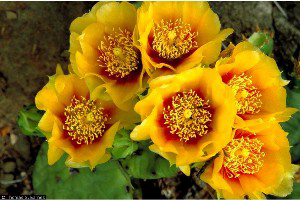The leaf pads, fruit, and seeds of devil's-tongue are edible. Devil's-tongue is listed as rare in Pennsylvania; endangered in Massachusetts, vulnerable in New York; and of special concern in Connecticut. It is native to the U.S. and is in the cactus family (Cactaceae).
Photo Credit: © Tom Barnes, University of Kentucky.
Opuntia humifusa
Common Name: devil's-tongue
Other Common Names: nopal del este, pricklypear
Plant Functional Group: Cactus
Class > Order > Family: Magnoliopsida > Caryophyllales > Cactaceae
What does the species look like?
Opuntia humifusa, devil's-tongue, is a perennial, evergreen cactus about 1 to 2 feet tall. It forms clumps of flattened one to three pad (stem) segments. Its pads are dark green and usually fleshy, unless stressed, when they become sunken and wrinkly. Glochids, (clusters of dense barbed hair), yellow to reddish-brown in color, appear on the stems. The flower of devil's-tongue is bright yellow with a red to red-orange center and is very showy, although each flower lasts for only one day. Its fruit is spiny and fleshy, and is purple when mature. The pulp inside the fruit is ruby red with tan seeds.
Devil's-tongue likes dry, sandy, and rocky areas in open pine woods and prairies, and along sand and gravel washes. It is a low water user, and prefers full sun and dry, well-drained soil. Devil’s-tongue tolerates heat and is intolerant of shade.
Long-tongued and short-tongued bees suck the nectar and collect pollen. The fruits and seeds are sometimes eaten by wild turkeys, skunks, and ground squirrels. The fruits and stems are eaten by rabbits, deer, and coyotes. Turtles and tortoise also eat the fruits of devil’s-tongue. The wildlife that eat the seeds aid in their dispersal.
Where is the species found?
States & Provinces
AL, AR, CO, CT, DE, FL, GA, IA, IL, IN, KS, KY, LA, MA, MD, MI, MN, MO, MS, MT, NC, NE, NJ, NM, NY, OH, OK, ON, PA, RI, SC, SD, TN, TX, VA, WI, WV
Special Considerations for Observing
WARNING: If you touch or brush against the pads, the glochids on the stems can cause severe skin irritation.
Which phenophases should I observe?
Do you see...?
Flowers
Flowers or flower buds More...
How many flowers and flower buds are present? For species in which individual flowers are clustered in flower heads, spikes or catkins (inflorescences), simply estimate the number of flower heads, spikes or catkins and not the number of individual flowers.
Less than 3 3 to 10 11 to 100 101 to 1,000 More than 1,000
Open flowers More...
What percentage of all fresh flowers (buds plus unopened plus open) on the plant are open? For species in which individual flowers are clustered in flower heads, spikes or catkins (inflorescences), estimate the percentage of all individual flowers that are open.
Less than 5% 5-24% 25-49% 50-74% 75-94% 95% or more
Fruits
Fruits Opuntia humifusa , the fruit is large, fleshy and berry-like and changes from green to reddish-yellow, red, maroon or brownish-red.More...
How many fruits are present?
Less than 3 3 to 10 11 to 100 101 to 1,000 More than 1,000
Ripe fruits Opuntia humifusa , a fruit is considered ripe when it has turned reddish-yellow, red, maroon or brownish-red.More...
What percentage of all fruits (unripe plus ripe) on the plant are ripe?
Less than 5% 5-24% 25-49% 50-74% 75-94% 95% or more
Recent fruit or seed drop More...
How many mature fruits have dropped seeds or have completely dropped or been removed from the plant since your last visit?
Less than 3 3 to 10 11 to 100 101 to 1,000 More than 1,000
What do these phenophases look like?
There is currently no photoguide available for this species. If you'd like help us create one, use the guidance document and species template provided here . Then send it via email to education@usanpn.org when it is complete.
